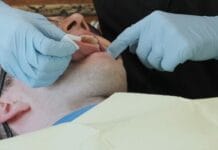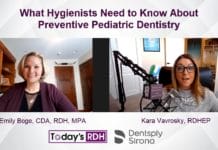Test Your Fluoride Knowledge!
Disclosure: This quiz is sponsored content from Dentsply Sirona as part of our sponsored partner program.
Now let's test your fluoride knowledge!
Fluoride is a naturally occurring mineral compound. Fluoride exists naturally in virtually all bodies of water on Earth.
“The fluoride ion comes from the element fluorine. Fluorine is an abundant element in the earth’s crust in the form of the fluoride ion. As a gas, it never occurs in its free state in nature, but exists only in combination with other elements as a fluoride compound. Fluoride compounds are components of minerals in rocks and soil. Water passes over rock formations and dissolves the fluoride compounds that are present, releasing fluoride ions. The result is that small amounts of fluoride are present in all water sources.1”
“Generally, surface water sources such as lakes, rivers, and streams have very low levels of fluoride. For example, Lake Michigan’s fluoride level is 0.17 ppm. As water moves through the earth, it contacts fluoride-containing minerals and carries away fluoride ions. The concentration of fluoride in groundwater varies according to such factors as the depth at which the water is found and the quantity of fluoride-bearing minerals in the area. In the United States, the natural level of fluoride in groundwater varies from very low levels to over 4 ppm. The fluoride level of the oceans ranges from 1.2 to 1.4 ppm. Fluoride is naturally present to some extent in all foods and beverages, but the concentrations vary widely.1”
1. McGinley, J.S, Stouflett, N.M., Rubin, M. (2005). Fluoridation Facts. American Dental Association.
For children six years or younger, which in-office fluoride treatment type is recommended?
Only fluoride varnish, as opposed to foam and gel, is recommended as an in-office fluoride treatment for children 6 and younger.1 “Fluoride varnish dispensed in unit doses has a lower potential for harm (i.e., nausea, vomiting, dental fluorosis) than do other forms of high-concentration topical fluoride agents because the amount of fluoride that is placed in the mouth by means of fluoride varnish is approximately one-tenth that of other professionally applied products.1”
Application of fluoride varnish is recommended beginning when the first tooth erupts.1,2 The American Academy of Pediatric Dentistry recommendations for children at high risk of caries is that fluoride varnish be applied to their teeth every 3 to 6 months.2 The 2013 American Dental Association guideline recommends the application of fluoride varnish at least every six months to both primary and permanent teeth in those subjects at elevated caries risk.1,2
1. Weyant, R.J., et al. (Nov, 2013). Topical Fluoride for Caries Prevention. JADA, 144(11). Retrieved from https://jada.ada.org/article/S0002-8177(14)60659-0/fulltext.
2. Clark, M.B., Slayton, R.L. (Sept, 2014). Fluoride Use in Caries Prevention in the Primary Care Setting. Pediatrics, 134(3). Retrieved from http://pediatrics.aappublications.org/content/134/3/626.
The only scientifically proven risk of excess (non-toxic) fluoride use is fluorosis. The risk of fluorosis exists for children until the age of 12.
“The only scientifically proven risk of excess (nontoxic) fluoride use is the development of fluorosis, which may occur with fluoride ingestion during tooth and bone development. Fluorosis of permanent teeth occurs when fluoride of sufficient quantity for a sufficient period of time is ingested during the time that tooth enamel is being mineralized. Fluorosis is the result of subsurface hypomineralization and porosity between the developing enamel rods. This risk exists in children younger than eight years, and the most susceptible period for permanent maxillary incisor fluorosis is between 15 and 30 months of age. The risk of fluorosis is influenced by both the dose and frequency of exposure to fluoride during tooth development. Recent evidence also suggests that individual susceptibility or resistance to fluorosis includes a genetic component.1”
“After eight years of age, there is no further risk of fluorosis (except for the third molars) because the permanent tooth enamel is fully mineralized. The vast majority of enamel fluorosis is mild or very mild and characterized by small white striations or opaque areas that are not readily noticeable to the casual observer. Although this type of fluorosis is of no clinical consequence, enamel fluorosis has been increasing in frequency over the last two decades to a rate of approximately 41% among adolescents because fluoride sources are more widely available in varied forms. Moderate and severe forms of enamel fluorosis are uncommon in the United States but have both an aesthetic concern and potentially a structural concern, with pitting, brittle incisal edges, and weakened groove anatomy in the permanent 6-year molars.1”
1. Clark, M.B., Slayton, R.L. (Sept, 2014). Fluoride Use in Caries Prevention in the Primary Care Setting. Pediatrics, 134(3). Retrieved from http://pediatrics.aappublications.org/content/134/3/626.
A one or four-minute application of 1.23% APF foam is as beneficial for caries prevention as a fluoride varnish application in permanent dentition.
The Council on Scientific Affairs of the American Dental Association (ADA CSA) conducted a systemic review of the literature regarding topical fluoride treatment agents. The panel found there is no benefit of 1.23% APF foam application twice per year for four minutes for caries prevention in permanent dentition in children 6-18 years of age. The ADA CSA also does not recommend foam use in adults older than 18 years old.1 If there is no benefit of a four-minute application, it’s easy to deduce there’s no benefit for a one-minute application of 1.23% APF foam, as a one-minute application has even less contact time of applied fluoride.
The ADA CSA panel found studies showing the benefits of fluoride varnish for children under the age of six, children 6-8, and for adults at risk for root surface caries.1 “Although there were no studies of coronal caries prevention in adults older than 18 years, the panel extrapolated the data from 6- through 18-year-olds to recommend using 2.26 percent varnish for this age group for both coronal and root caries. The benefits were judged to outweigh the potential for harm for all age groups.1”
1. Weyant, R.J., et al. (Nov, 2013). Topical Fluoride for Caries Prevention. JADA, 144(11). Retrieved from https://jada.ada.org/article/S0002-8177(14)60659-0/fulltext.
Community water fluoridation has been shown to reduce to dental decay by what percent?
“Community water fluoridation is the practice of adding a small amount of fluoride to the water supply. It has been heralded as 1 of the top 10 public health achievements of the 20th century by the CDC. Community water fluoridation is a safe, efficient, and cost-effective way to prevent tooth decay and has been shown to reduce tooth decay by 29%. It prevents tooth decay through the provision of low levels of fluoride exposure to the teeth over time and provides both topical and systemic exposure.1”
- It is estimated that every dollar invested in water fluoridation saves $38 in dental treatment costs.1,2”
- Texas saves $24 per child, per year in Medicaid expenditures because of the dental decay that is prevented by fluoridated water2.
- Water fluoridation has saved Colorado nearly $149 million by avoiding unnecessary dental treatment2.
- In New York, Medicaid enrollees in counties where water fluoridation was rare needed 33.4% more restorations, root canals, and extractions than those in counties with fluoridated water2.
1. Clark, M.B., Slayton, R.L. (Sept, 2014). Fluoride Use in Caries Prevention in the Primary Care Setting. Pediatrics, 134(3). Retrieved from http://pediatrics.aappublications.org/content/134/3/626.
2. Fluoride Myths & Facts. American Academy of Pediatrics: Campaign for Dental Health. Retrieved from https://ilikemyteeth.org/fluoridation/fluoride-myths-facts/.














